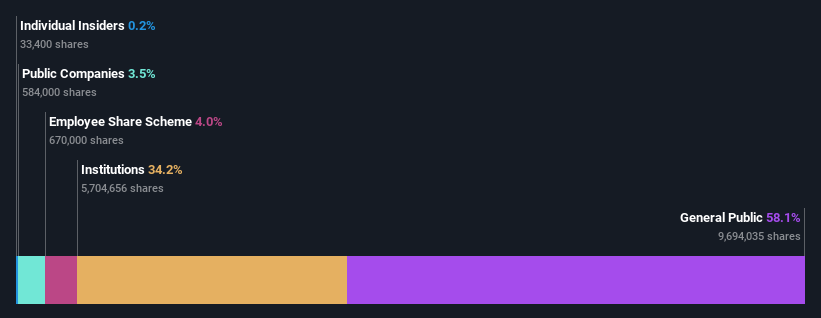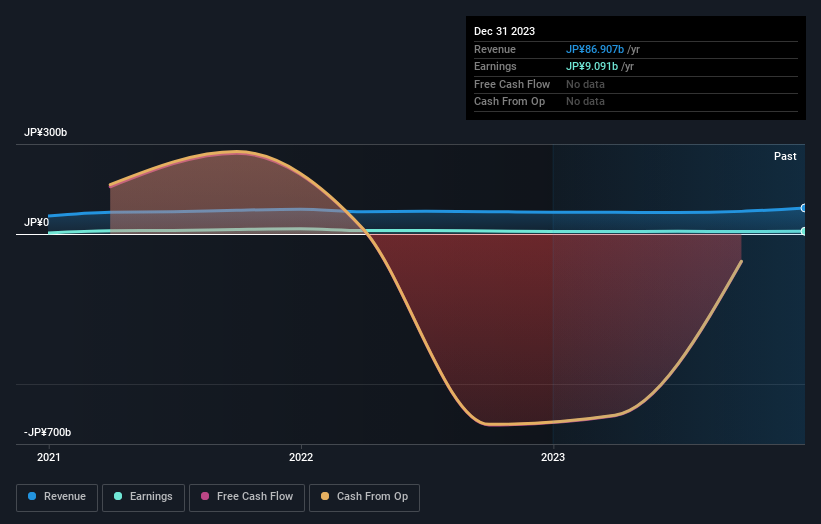Stock Analysis
retail investors who own 58% along with institutions invested in The Bank of Nagoya, Ltd. (TSE:8522) saw increase in their holdings value last week

Key Insights
- The considerable ownership by retail investors in Bank of Nagoya indicates that they collectively have a greater say in management and business strategy
- 42% of the business is held by the top 25 shareholders
- Institutions own 34% of Bank of Nagoya
If you want to know who really controls The Bank of Nagoya, Ltd. (TSE:8522), then you'll have to look at the makeup of its share registry. With 58% stake, retail investors possess the maximum shares in the company. In other words, the group stands to gain the most (or lose the most) from their investment into the company.
While retail investors were the group that reaped the most benefits after last week’s 8.3% price gain, institutions also received a 34% cut.
Let's take a closer look to see what the different types of shareholders can tell us about Bank of Nagoya.
See our latest analysis for Bank of Nagoya

What Does The Institutional Ownership Tell Us About Bank of Nagoya?
Institutional investors commonly compare their own returns to the returns of a commonly followed index. So they generally do consider buying larger companies that are included in the relevant benchmark index.
Bank of Nagoya already has institutions on the share registry. Indeed, they own a respectable stake in the company. This implies the analysts working for those institutions have looked at the stock and they like it. But just like anyone else, they could be wrong. It is not uncommon to see a big share price drop if two large institutional investors try to sell out of a stock at the same time. So it is worth checking the past earnings trajectory of Bank of Nagoya, (below). Of course, keep in mind that there are other factors to consider, too.

Hedge funds don't have many shares in Bank of Nagoya. Looking at our data, we can see that the largest shareholder is Nissay Asset Management Corporation with 4.4% of shares outstanding. Bank of Nagoya Employee Stock Ownership Plan is the second largest shareholder owning 4.0% of common stock, and Toyota Motor Corporation holds about 3.5% of the company stock.
A deeper look at our ownership data shows that the top 25 shareholders collectively hold less than half of the register, suggesting a large group of small holders where no single shareholder has a majority.
While studying institutional ownership for a company can add value to your research, it is also a good practice to research analyst recommendations to get a deeper understand of a stock's expected performance. As far as we can tell there isn't analyst coverage of the company, so it is probably flying under the radar.
Insider Ownership Of Bank of Nagoya
The definition of company insiders can be subjective and does vary between jurisdictions. Our data reflects individual insiders, capturing board members at the very least. Management ultimately answers to the board. However, it is not uncommon for managers to be executive board members, especially if they are a founder or the CEO.
Insider ownership is positive when it signals leadership are thinking like the true owners of the company. However, high insider ownership can also give immense power to a small group within the company. This can be negative in some circumstances.
Our information suggests that The Bank of Nagoya, Ltd. insiders own under 1% of the company. It appears that the board holds about JP¥226m worth of stock. This compares to a market capitalization of JP¥113b. Many tend to prefer to see a board with bigger shareholdings. A good next step might be to take a look at this free summary of insider buying and selling.
General Public Ownership
The general public, mostly comprising of individual investors, collectively holds 58% of Bank of Nagoya shares. This level of ownership gives investors from the wider public some power to sway key policy decisions such as board composition, executive compensation, and the dividend payout ratio.
Public Company Ownership
It appears to us that public companies own 3.5% of Bank of Nagoya. It's hard to say for sure but this suggests they have entwined business interests. This might be a strategic stake, so it's worth watching this space for changes in ownership.
Next Steps:
I find it very interesting to look at who exactly owns a company. But to truly gain insight, we need to consider other information, too.
I always like to check for a history of revenue growth. You can too, by accessing this free chart of historic revenue and earnings in this detailed graph.
Of course this may not be the best stock to buy. So take a peek at this free free list of interesting companies.
NB: Figures in this article are calculated using data from the last twelve months, which refer to the 12-month period ending on the last date of the month the financial statement is dated. This may not be consistent with full year annual report figures.
Valuation is complex, but we're helping make it simple.
Find out whether Bank of Nagoya is potentially over or undervalued by checking out our comprehensive analysis, which includes fair value estimates, risks and warnings, dividends, insider transactions and financial health.
View the Free AnalysisHave feedback on this article? Concerned about the content? Get in touch with us directly. Alternatively, email editorial-team (at) simplywallst.com.
This article by Simply Wall St is general in nature. We provide commentary based on historical data and analyst forecasts only using an unbiased methodology and our articles are not intended to be financial advice. It does not constitute a recommendation to buy or sell any stock, and does not take account of your objectives, or your financial situation. We aim to bring you long-term focused analysis driven by fundamental data. Note that our analysis may not factor in the latest price-sensitive company announcements or qualitative material. Simply Wall St has no position in any stocks mentioned.
About TSE:8522
Bank of Nagoya
The Bank of Nagoya, Ltd. provides various banking and financial services in Japan.
Average dividend payer with acceptable track record.

